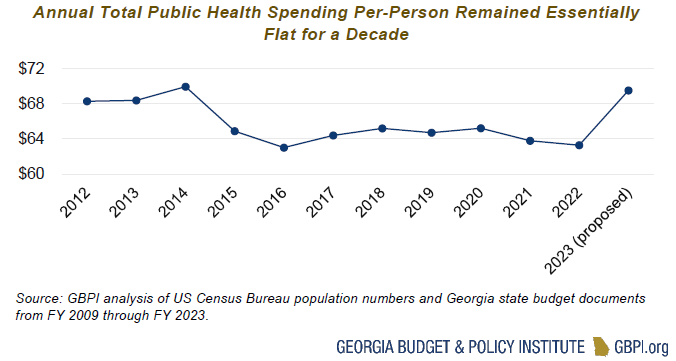GBPI Research Director David Schaefer also contributed to this report.
Gov. Brian Kemp proposed a 2023 budget of $334.9 million in state general funds for the Department of Public Health (DPH). The agency is also set to receive $13.8 million from a tobacco industry legal settlement and $1.6 million from the Brain and Spinal Injury Trust Fund. In addition to these state funds, the proposed budget includes $396 million in federal funds. About 51.4 percent of the agency’s total budget comes from the federal government through programs such as Special Supplemental Nutrition Program for Women, Infants and Children (WIC), the Maternal and Child Health Services Block Grant and the Temporary Assistance for Needy Families Block Grant (TANF).[1]
By the Numbers
DPH first received funding as a standalone department in FY 2012. Before that, the state’s public health spending was part of a division within the Department of Human Resources or the Department of Community Health. DPH leads the state’s work in preventing disease, promoting population health and well-being and preparing for emergency response efforts.
The agency funds and provides technical assistance to the 159 county health departments and 18 public health districts. DPH also oversees two attached agencies: The Brain and Spinal Injury Trust Fund Commission distributes grants to improve quality of life for Georgians with traumatic brain and spinal cord injuries and The Georgia Trauma Care Network Commission distributes money to stabilize and improve the state’s trauma care system.
Amended FY 2022 Highlights
Compared to FY 2022, total spending in the proposal for the Georgia Department of Public Health incorporates an increase of $47.7 million, or approximately 16.6 percent. Highlights include:
- $29.2 million total increase to provide a $5,000 cost of living adjustment (COLA) for all full-time, benefit-eligible state employees to address agency recruitment and retention needs.
- $8.6 million increase to reflect higher revenue collections on fireworks excise taxes and Super Speeder fees that help fund the Georgia Trauma Network Commission.
- $28,060 increase in tobacco industry settlement funds.
FY 2023 Budget Highlights
The proposed 2023 budget adds $76 million from the prior year, or approximately a 26 percent increase. It also is $58 million higher than the FY 2020 (pre-pandemic) budget. Key changes include:
- $40.5 million total increase to provide a $5,000 COLA for employees with $36.2 million going to county boards delivering local public health services.
- $500,000 in new funds to provide a comprehensive care management pilot for high-risk pregnancy populations.
- $2.8 million increase in new funds to provide administrative support to all departmental programs in the Georgia Department of Public Health (DPH).
- $4.8 million in new funds for Emergency Preparedness/Trauma System Improvement.
- $7 million increase to support the Georgia Trauma Care Network Commission.
- $9.9 million funding increase to address state funds shortfall for the AIDS Drug Assistance Program (ADAP) per the state match requirement in the Ryan White Care Act Title II Award.[2]
- $45,709 in new funds for the third year of a three-year pilot to provide PrEP for individuals at risk of contracting HIV.
While the AFY 2022 and FY 2023 budgets provide substantial increases in critical areas—such as pay raises for frontline public health workers, many of whom oversee vaccinations throughout the state—Georgia should continue to increase state investments in other key functions such as epidemiology. In fact, much of the investments in FY 2022 in the public health agency did not come from state funds; rather, the state relied heavily on one-time federal money to respond to COVID-19 and has continued to do so. Georgia historically has ranked in the bottom third of states with regards to per capita public health expenditures.
Georgia should consider increasing sustained state investments in public health emergency preparedness both to get through COVID-19 and to buttress systems in advance of the next crisis. Investing in those systems can help shield hospital systems from added stress and help protect fragile rural hospitals from closure. Importantly, well-buttressed public health systems coupled with full Medicaid expansion can also help prevent the exacerbation of historic racial inequities, and full Medicaid expansion would free up $1.4-$1.9 billion in state funds to invest in strengthening public health. These simple, actionable steps could help prevent the economic fallout of the next pandemic from falling as sharply on frontline workers, who tend to be Black and Brown and come from immigrant communities.

Endnotes
[1] The information in this overview is derived from GBPI analysis of data from Governor’s Office of Planning and Budget. (2023). The governor’s budget report amended fiscal year 2022 and fiscal year 2023. https://opb.georgia.gov/afy-2022-and-fy-2023-governors-budget-report-0 and US Department of Agriculture, Food and Nutritional Service, WIC Data Tables. (2022, Jan. 7). Annual state-level data: Food costs. https://www.fns.usda.gov/sites/default/files/resource-files/24wicfood$-1.pdf
[2] United States, U.S. Department of Health and Human Services, Health Resources and Services Administration. (2016). AIDS Drug Assistance Program (ADAP) manual (pp. 22-23). Rockville, Maryland: HIV/AIDS Bureau: Division of State HIV/AIDS Programs.









